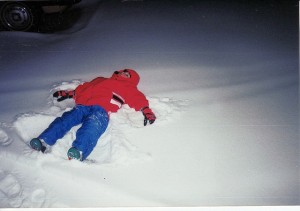21 Jan Winter Injury Prevention
 A beautiful sight / We’re happy tonight / Walking in a winter wonderland.
A beautiful sight / We’re happy tonight / Walking in a winter wonderland.
For many people, especially those of us here in the south, this song encapsulates the wonder of a snowy winter. For us a white winter is the thing of dreams.
That is until it actually happens. Then we panic. We cancel all the schools, and there’s no bread or milk in any grocery store south of the Mason-Dixon line.
Truth is that we’re just not bred for cold weather. We have no real experience with the extreme cold. Many of us wouldn’t know what to do if a real winter emergency happened.
When cold weather does come our way many of us are at risk because we don’t know how to prevent winter injuries. If a winter storm does surprise us, learning to prevent common winter injuries can keep your family safe.
Hypothermia and Frostbite
Both frostbite and hypothermia can be caused by prolonged exposure to cold temperatures. Both can be potentially deadly. It only takes five minutes of exposure in negative degree temperatures for frostbite to develop.
Frostbite happens when a certain part of your body gets too cold. Ice crystals form in your tissue and around your cells. OUCH!
Hypothermia is when your overall body temperature drops too low. Normal body temperature averages 98.6 degrees. With hypothermia, core temperature drops below 95 degrees. With severe hypothermia, it drops to 82 degrees or lower.
The people with the greatest risk of developing hypothermia are the elderly because they have problems regulating their body temperature and infants who lose heat faster. Symptoms of hypothermia include loss of coordination, slurred speech, and eventual loss of consciousness and cardiac arrest.
Avoid frostbite and hypothermia by:
- Maintaining proper fitness. Proper blood circulation can help regulate your body temperature.
- Limiting exposure to cold temperatures. If possible look for indoor fitness solutions like joining a gym or yoga classes.
- Covering everything including your face, neck and hands. Be sure to wear warm hats, gloves,and rubber sole shoes.
- Warming up. Cold muscles are more prone to injury. Be sure you’re doing a short warm up prior to any winter activity. Before you go outside do some light exercise and some stretching to
- prevent injury.
- Stay dry. Staying dry is the key to preventing cold temperature injury.
- Pacing yourself. If you start to sweat it can cause your clothing to become damp which will accelerate heat loss.
- Dressing in layers of light loose clothing. Layers can be added and taken off. They also pocket warm air that acts as insulation.
Both frostbite and hypothermia are potentially life threatening so always seek medical care. But if you’re in an emergency situation where medical attention is not immediately available start by focusing on the hypothermia. You need to raise the person’s core temperature before you move to the extremities.
First aid for hypothermia:
- Move the person to a warm dry area as soon as possible
- Remove any wet clothing
- Begin rewarming the person with extra dry clothes and blankets. Wrapping an electric blanket around the torso can help. If no blankets are available, use your own body heat.
- If the victim is conscious, give them a warm beverage, but avoid alcoholic and caffeinated beverages. Never give liquids to an unconscious person.
- Do not apply heat directly to the hands and feet. Applying direct heat to extremities will cause a further drop in core temperature.
First aid for frostbite:
- Move to a warm area
- Remove any constricting or wet clothing especially around the frostbitten area.
- Elevate the area to reduce swelling.
- Do not rub or massage the frostbitten area. It will further damage the tissue
- Never rub area with snow or ice.
- If there is a chance of the area refreezing, it’s better to leave it frozen. More damage occurs if the tissue is thawed and then refrozen so be sure you’re able to stay in a warm place before you rewarm the person.
Slips and Falls
Slips and falls are also a big concern in the winter months as rain, ice, and snow make can make walking difficult. Take your time when you’re walking outside in the rain and snow. Take small steps and wear shoes with a good rubber tread.
If ice forms in a high traffic area, spread sand, rock salt, or kitty litter around to improve traction. If you feel yourself falling, don’t fight the fall. Try to relax your muscles and roll onto your side or bottom. The less tense you are the less likely you are to be hurt. For more tips for preventing falls this winter check out these blogs:



Sorry, the comment form is closed at this time.